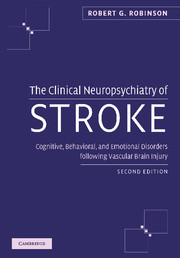 The Clinical Neuropsychiatry of Stroke
The Clinical Neuropsychiatry of Stroke Book contents
- Frontmatter
- Contents
- Preface
- Part I Introduction
- Part II Poststroke depression
- 5 Diagnosis of depression
- 6 Prevalence of depressive disorders
- 7 Phenomenology and specificity of depressive symptoms
- 8 Natural course of depression
- 9 Delayed-onset depression
- 10 Relationship to lesion location
- 11 Relationship of depression to cerebral dominance and structural asymmetries
- 12 Relationship of depression to bilateral hemisphere brain injury
- 13 Relationship of depression to physical impairment
- 14 Relationship to cognitive impairment and treatment
- 15 Relationship of aphasia to depression
- 16 Relationship of depression to social functioning
- 17 Relationship to premorbid risk factors
- 18 Mortality and treatment
- 19 Suicidal thoughts and plans
- 20 Biological markers
- 21 Mechanisms of poststroke depression
- 22 Treatment of poststroke depression
- 23 Prevention of poststroke depression
- Part III Poststroke mania
- Part IV Poststroke anxiety disorders
- Part V Other poststroke disorders
- Index
21 - Mechanisms of poststroke depression
from Part II - Poststroke depression
Published online by Cambridge University Press: 01 October 2009
- Frontmatter
- Contents
- Preface
- Part I Introduction
- Part II Poststroke depression
- 5 Diagnosis of depression
- 6 Prevalence of depressive disorders
- 7 Phenomenology and specificity of depressive symptoms
- 8 Natural course of depression
- 9 Delayed-onset depression
- 10 Relationship to lesion location
- 11 Relationship of depression to cerebral dominance and structural asymmetries
- 12 Relationship of depression to bilateral hemisphere brain injury
- 13 Relationship of depression to physical impairment
- 14 Relationship to cognitive impairment and treatment
- 15 Relationship of aphasia to depression
- 16 Relationship of depression to social functioning
- 17 Relationship to premorbid risk factors
- 18 Mortality and treatment
- 19 Suicidal thoughts and plans
- 20 Biological markers
- 21 Mechanisms of poststroke depression
- 22 Treatment of poststroke depression
- 23 Prevention of poststroke depression
- Part III Poststroke mania
- Part IV Poststroke anxiety disorders
- Part V Other poststroke disorders
- Index
Summary
In considering the mechanisms of poststroke depression, it should be kept in mind that important clinical findings such as cognitive impairment is associated with major, but not minor depression, following the left, but not right, hemisphere stroke (Chapter 14) need to be integrated or explained by the proposed mechanisms of depression. Additional clinical findings include depression is significantly associated with left frontal and left basal ganglia lesions but not comparable lesions of the right hemisphere during the acute period following stroke (Chapter 10). Furthermore, major depression is associated with proximity of the lesion to the frontal pole while minor depression is associated with posterior lesions of the left hemisphere during the acute poststroke period (Chapter 10). Delayed-onset depression is more strongly associated with social impairment than acute onset depression (Chapter 9). Thus, it seems likely that there are multiple kinds of depression following stroke and that major depression, minor depression, acute onset, delayed onset, left hemisphere lesion induced, and right hemisphere lesion induced depressions may have different mechanisms.
The major debate in the literature, however, is whether poststroke depression results from psychological response to impairment/loss or whether it results from neurophysiological response to brain injury. McHugh and Slavney (1998) have described this as a debate about whether the disease perspective or the life story perspective provides greater insight into the cause of poststroke depression.
- Type
- Chapter
- Information
- The Clinical Neuropsychiatry of StrokeCognitive, Behavioral and Emotional Disorders following Vascular Brain Injury, pp. 237 - 250Publisher: Cambridge University PressPrint publication year: 2006


